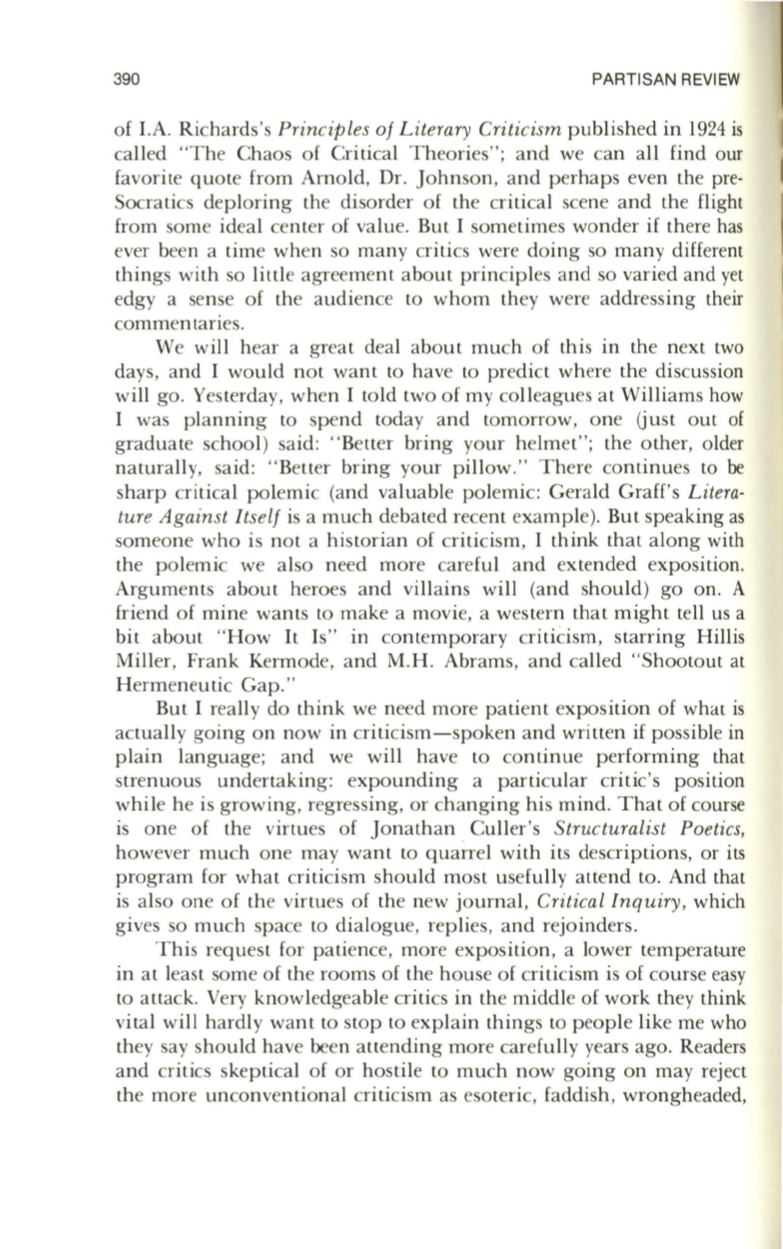
390
PARTISAN REVIEW
of LA. Richards's
Principles of Literary Criticism
published in 1924 is
called "The Chaos of Critical Theories"; and we can all find our
favorite quote from Arnold, Dr. Johnson, and perhaps even the pre–
Socratics deploring the disorder of the critical scene and the flight
from some ideal center of value. But I sometimes wonder if there has
ever been a time when so many critics were doing so many different
things with so little agreement about principles and so varied and yet
edgy a sense of the audience to whom they were addressing their
commen taries.
We will hear a great deal about much of this in the next two
days, and I would not want to have to predict where the discussion
will go. Yesterday, when I told two of my colleagues at Williams how
I was planning to spend today and tomorrow, one Uust out of
graduate school) said: "Better bring your helmet"; the other, older
naturally, said: "Better bring your pillow." There continues to
be
sharp critical polemic (and valuable polemic: Gerald Graff's
Litera–
ture Against Itself
is a much debated recent example). But speaking as
someone who is not a historian of criticism, I think that along with
the polemi<: we also need more careful and extended exposition.
Arguments about heroes and villains will (and should) go on. A
friend of mine wants to make a movie, a western that might tell us a
bit about "How It Is" in contemporary critiCism, starring Hillis
Miller, Frank Kermode, and M.H. Abrams, and called "Shootout at
Hermeneutic Gap."
But I really do think we need more patient exposition of what is
actually going on now in criticism-spoken and written if possible in
plain language; and we will have to continue performing that
strenuous undertaking: expounding a particular critic's position
while he is growing, regressing, or changing his mind. That of course
is one of the virtues of Jonathan Culler's
Structuralist Poetics,
however much one may want to quarrel with its descriptions, or its
program for what criticism should most usefully attend to. And that
is also one of the virtues of the new journal,
Critical Inquiry,
which
gives so much space to dialogue, replies, and rejoinders.
This request for patience, more exposition, a lower temperature
in at least some of the rooms of the house of criticism is of course easy
to attack. Very knowledgeable critics in the middle of work they think
vital will hardly want
to
stop to explain things to people like me who
they say should have been attending more carefully years ago. Readers
and critics skeptical of or hostile to much now going on may reject
the more unconventional criticism as esoteric, faddish, wrongheaded,


